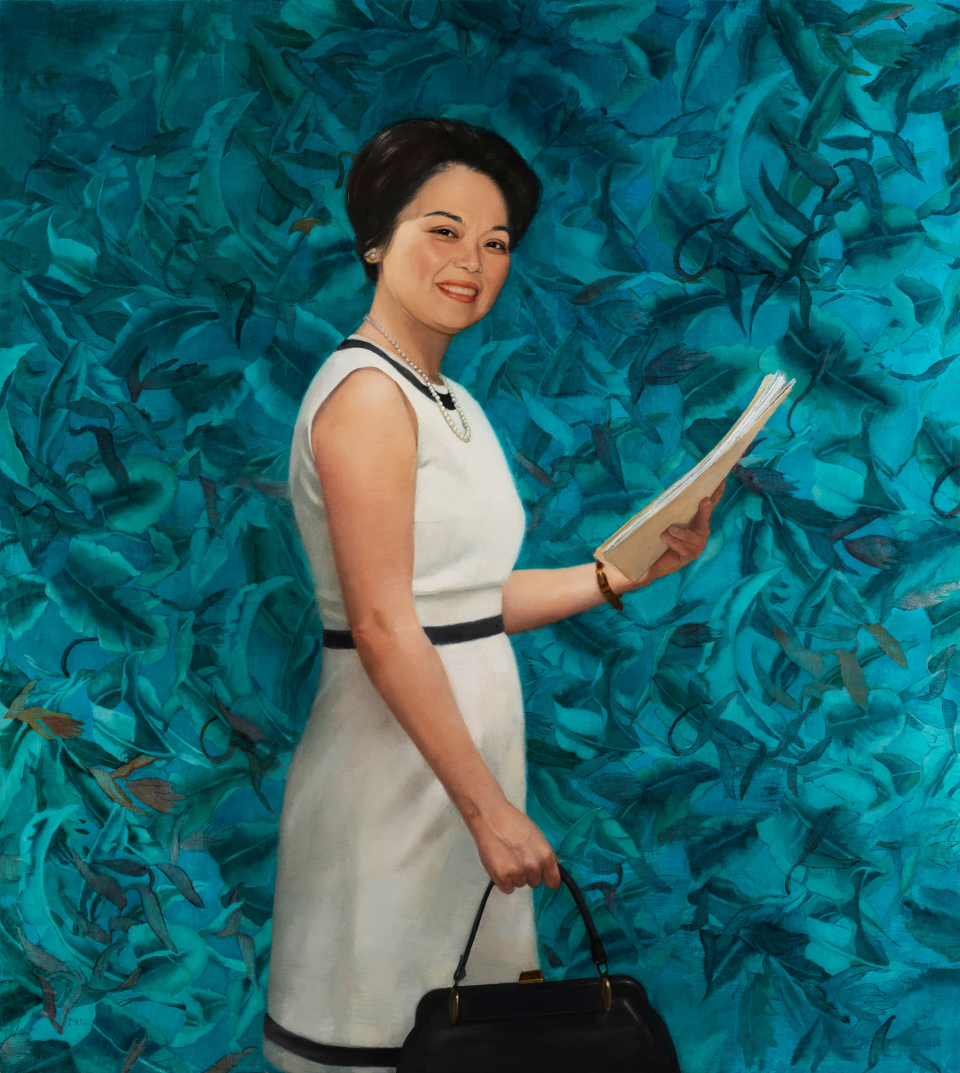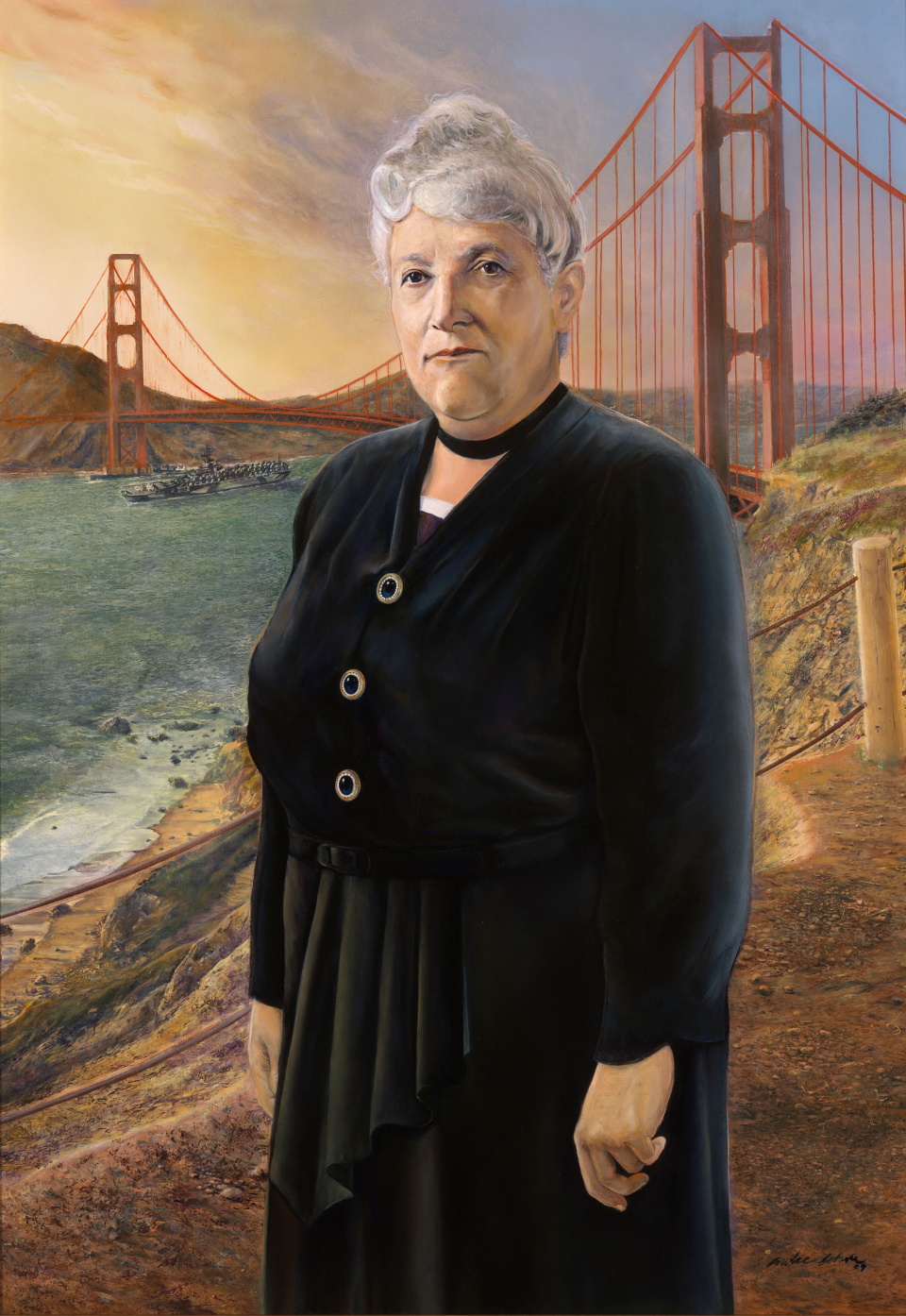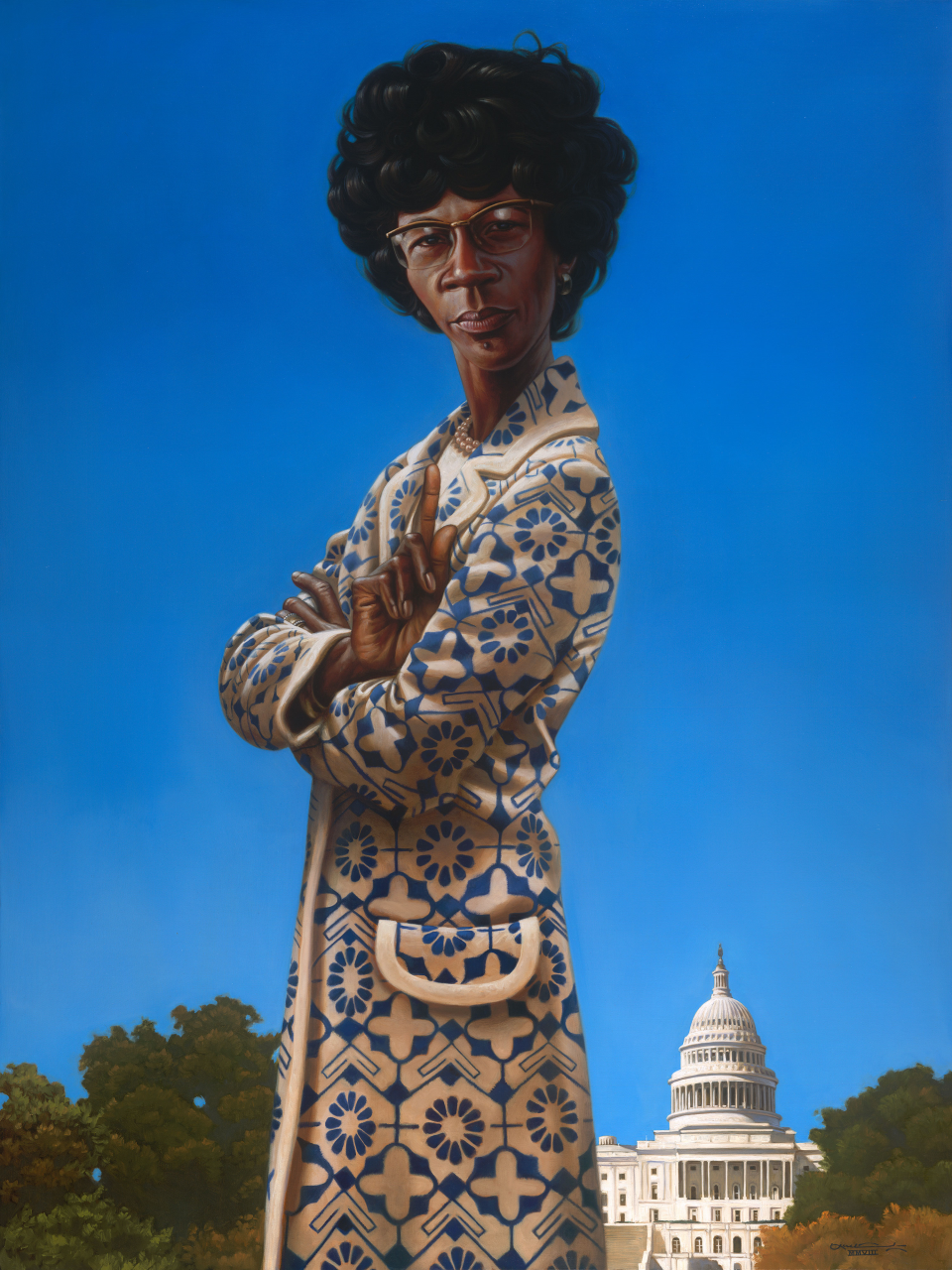21st-Century Portrait Commissions
In 2002, the House of Representatives began an initiative to identify noteworthy former Members with significant legislative achievements or symbolic importance in House history who did not fall into the limited categories of Representatives who traditionally had portraits painted—namely, Speakers of the House and committee chairs. Over the subsequent years, portrait commissions resulted in wider representation of historical Members of Congress and of more contemporary approaches to portraiture within the House Collection of Art and Artifacts. These commissioned portraits create a robust, inclusive, and lasting visual record of remarkable individuals spanning House history, U.S. geography, and political affiliation.
The Portraits
Patsy Takemoto Mink, oil on aluminum, Sharon Sprung, 2022
 /tiles/non-collection/p/portraits-commissions-mink-2022_030_000.xml
Collection of the U.S. House of Representatives; photography courtesy of Sharon Sprung and Gallery Henoch, New York
/tiles/non-collection/p/portraits-commissions-mink-2022_030_000.xml
Collection of the U.S. House of Representatives; photography courtesy of Sharon Sprung and Gallery Henoch, New York
About this object
Trailblazing and seriousness of purpose marked
Patsy Mink’s career in the House of Representatives. The first woman of color and first Asian-American woman elected to Congress, in 1964, Mink’s work led to significant changes in education in the United States, including Title IX of the Education Amendments of 1972, which barred discrimination based on sex in institutions receiving federal funding; the early childhood education program Head Start; and the Women’s Educational Equity Act of 1974, which promoted gender equity in schools. The colors of the Pacific Ocean and abstractions of flora from her home state of Hawaii—heliconia, bird-of-paradise, and others—form the background of the portrait. The setting evokes Mink’s uniqueness at the outset of her 13-term career in the House—as a Representative from a recently admitted state, a Hawaiian and woman of color, and an activist.
Florence Prag Kahn, oil on canvas, Andre White, 2009
 /tiles/non-collection/p/portraits-commissions-kahn-2009_005_000.xml
Collection of the U.S. House of Representatives
/tiles/non-collection/p/portraits-commissions-kahn-2009_005_000.xml
Collection of the U.S. House of Representatives
About this object
Florence Kahn, known for her effectiveness and sparkling wit, represented California in Congress from 1925 to 1937. Her service included several firsts: she was the first woman to sit on the Appropriations and Military Affairs Committees, as well as the first Jewish woman in Congress. She is shown in her portrait amidst the striking vistas of her San Francisco Bay–area district. Some of the results of her legislative work are incorporated into the landscape. While she served on the Appropriations Committee, the Golden Gate and Bay Bridges were prominent infrastructural projects. The ship crossing the bay behind her alludes to the Naval Air Depot Kahn secured for the area, which opened just before the United States entered World War II.
Shirley Anita Chisholm, oil on canvas, Kadir Nelson, 2008
 /tiles/non-collection/p/portraits-commissions-chisholm-2009_001_000.xml
Collection of the U.S. House of Representatives
/tiles/non-collection/p/portraits-commissions-chisholm-2009_001_000.xml
Collection of the U.S. House of Representatives
About this object
Shirley Chisholm’s election to represent her Brooklyn, New York, district made her the first African-American woman in Congress when she was sworn in on January 3, 1969. Chisholm was known for her strong principles and willingness to stand up for them. While in Congress, she continued to blaze a trail, becoming the first Black woman—and second woman ever—to serve on the Rules Committee. Her boldness is emphasized in the portrait commemorating her service. Shown in a striking and stylish coat, she stands her ground before the Capitol. Nicknamed “Fighting Shirley,” the former educator earned her reputation from the beginning of her service, stating that she had “no intention of just sitting quietly and observing.”
View the other 21st-century portrait commissions:
Dalip Singh Saund, oil on canvas, Jon R. Friedman, 2007
In 1956,
Dalip Saund of California became the first
Asian-Pacific American elected to the House of Representatives. The portrait shows the Congressman standing in the Cannon Rotunda, framed on two sides by trompe l’oeil marble panels. The vertical panel outlines significant events and inspirations in his life, including images of his philosophical heroes Mahatma Gandhi and Abraham Lincoln. Saund’s own words are inscribed along the bottom: “There is no room in the United States of America for second-class citizenship.” This statement, and the multicolored stone, represent Saund’s fight against racial discrimination and his work for immigrants’ rights. Personal experience informed the sentiment as well. He was barred from becoming a U.S. citizen for years because of immigration laws that blocked citizenship for people from Asian countries until 1946.
Romualdo Pacheco, oil on canvas, Daniel Greene, 2005
Romualdo Pacheco of California took his seat in 1877, becoming the first
Hispanic American elected to the House of Representatives. The 2005 portrait depicts Pacheco in his role as the first Hispanic American to chair a full committee in the House. Standing in a Capitol meeting room, Pacheco presides over the Private Land Claims Committee, which he chaired from 1881 to 1883. He is surrounded by maps, an essential tool of his committee. Other period details include the 19th-century mantel clock and the Thomas U. Walter–designed marble fireplace mantel.
Joseph Hayne Rainey, oil on canvas, Simmie Knox, 2004
In 1870,
Joseph Rainey became the first
African American sworn into the House of Representatives, and went on to represent his South Carolina district for eight years. He argued for federal protection from Ku Klux Klan violence and demanded legislation to ensure African Americans’ civil rights. The portrait sets Rainey in the House Connecting Corridor on the second floor of the Capitol, seated in a distinctive House Chamber
chair designed in 1857. The half-finished Washington Monument is visible through the window, both situating the scene historically and representing the nation’s incomplete journey toward equality.
Jeanette Rankin, oil on canvas, Sharon Sprung, 2004
Jeannette Rankin’s portrait communicates both the cultural importance and the loneliness of her position as the first
woman elected to Congress. Standing in the empty corridor adjacent to the House Chamber, Rankin is depicted holding the
Washington Post, in which her 1917 swearing-in to represent a district in Montana was front-page news. The vacant, cool-toned space and her look of resigned calm reflect her singularity as a woman in the legislative branch three years before women’s suffrage became federal law.
Abraham Lincoln, oil on canvas, Ned Bittenger, 2004
Although
Abraham Lincoln’s single term in Congress from 1847 to 1849 is notable as his first appearance on the national stage, his later distinction merited commemoration of this earlier foray into leadership. This portrait addresses the challenge of depicting a famous face before it settled into the well-known, craggy visage of President Lincoln. The portrait strikes a compromise between perfect accuracy and depicting a man not too far removed from the most recognizable period of his life. The setting includes numerous details of the
House Chamber’s appearance in the 1840s, including the voluminous red drapery, the George Washington
portrait, and the
furniture designed by Thomas Constantine.
John Quincy Adams, oil on canvas, Ed Ahlstrom (after Jean-Baptiste-Adolphe Gibert), 2002
The House’s original John Cranch portrait of
John Quincy Adams—the only President of the United States to serve in Congress after his presidency—was destroyed in a fire in 1851. A century and a half later, the House commissioned a replacement portrait. Painted after an 1844 likeness of Adams by French artist Jean-Baptiste-Adolphe Gibert in the State Department’s collection, this work depicts Adams as he appeared during his post-presidency House service, from 1831 to 1849. By this time, in addition to the presidency, Adams previously served in the U.S. House (1803–1809) and held several ambassadorships. Nonetheless, he said that “No election or appointment conferred upon me ever gave me so much pleasure” as his return to the House in 1831.
James Madison Jr., oil on canvas, Bradley Stevens (after Charles Willson Peale), 2002
James Madison’s roles as the “Father of the Constitution,” an author of
The Federalist Papers, and contributor to the Bill of Rights earned him a commissioned portrait in 2002. This portrait, modelled after a Charles Willson Peale work, replaced a painting by artist Gilbert Stuart that adorned the Capitol in the 19th century but was lost in the 1851 fire that destroyed the Congressional Library. James Madison also represented Virginia in the Continental Congress and in the House of Representatives for its first four Congresses (1789–1797).


